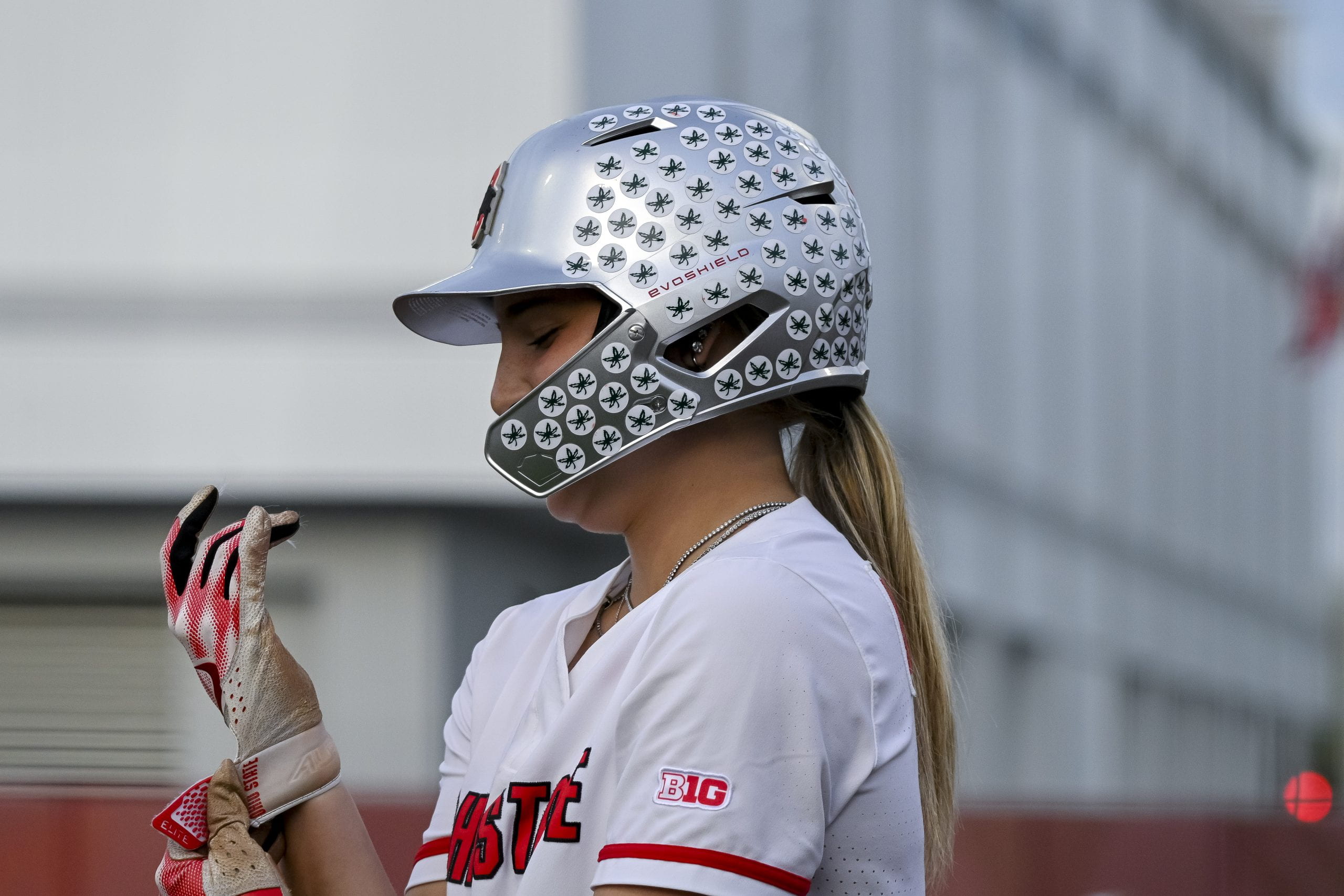
Junior infielder Kami Kortokrax restraps her gloves before going to bat during Ohio State’s 16-8 win over Penn State in six innings Tuesday at Buckeye Field. Credit: Lance Haupricht | Lantern Photographer
After losing an eight-year winning streak for the Ohio State football team against Michigan, Kourt Williams II returned from the game devastated.
The graduate student was already upset about the loss — but then the comments started coming in.
“I got a whole bunch of [direct messages] on Instagram from a whole bunch of fans saying all kinds of negative stuff, calling me all kinds of names and talking about my teammates,” Williams said. “I talked to some of my teammates, too, and they got some crazy stuff, as well.”
These comments exacerbated what Williams already knew and felt. Even outside of football, Division I athletes are often minimized in the mental health conversation due to their supernatural embodiment at high-profile schools such as Ohio State.
“[The public sees] us on TV and they think we’re, I don’t know, superhuman?” Williams said. “They forget that we are human, that we got thoughts and emotions. We’re not kids, but a lot of us were at the prom four years ago, and I think they do lose sight of that sometimes.”
Joshua Norman, a psychiatrist for the Ohio State athletic department, said many fans do not understand the mental stress that young athletes undergo.
“I think a lot of times, what I’ve noticed in the fans, is they tend to forget that these are college-age students, 18-22, with a tremendous amount of pressure on them,” Norman said. “There’s a lot of pressure at such a young age and that pressure could increase somebody’s risk to develop an anxiety disorder or develop a depressive disorder.”
For Kami Kortokrax, a junior on the Ohio State women’s softball team, there are a variety of high-pressure moments being an athlete at a top school.
“When you fail at such a high platform in front of so many different people, It’s easy to get in your own head,” Kortokrax said. “When you deal with failure, it makes you question a lot, doubt yourself and your capabilities.”
While athletes face extreme pressures at times, Norman said they also have a protective factor within the team sport dynamic.
“They have the support of the teammates, they have the support of the coaches, routinely engaging in physical activity and nutrition plans,” Norman said.
Max Rodney, a senior on the Ohio State fencing team, said when he’s going through a mental challenge, there are several methods he turns to, including a meditation app provided by the school. Still, he said, nothing compared to talking to his team.
“We’re always opening up to each other, we were just talking about it today actually,” Rodney said. “Me and my head coach were talking about stuff that was on my mind and what’s going on, so it’s a really open space.”
The mental stress comes from a sense of identity fraud after injury or the transition out of their sport for many players, Norman said.
“At the end of the day, sports will end for all players whether they play just in college or they go to professional or sometimes folks get an injury that ends their career,” Norman said. “So I think working to help develop a sense of identity outside of their sport is really important.”
Williams remembers seeing guys go off to play professionally and come back after their careers ended with no clue of what their next step was.
“I told myself a few years back that — that wasn’t going to be me,” Williams said. “Ohio State has plenty of resources if you’re proactive about trying, nothing is just going to happen by chance, you have to go out and get it.”
Norman said he appreciates how strongly the Big Ten Conference feels toward mental health.
“They have mandated that each school has mental health professionals on staff and available to their student-athletes,” Norman said. “So I think that’s another really great step.”
In addition to using these resources, Kortokrax said working toward bettering mental health strengthens an athlete’s mind.
“If you can build your mental strength to be strong enough in those times that you fail, you understand that those failures don’t define you and you’re going to get another opportunity to bounce back,” Kortokrax said.
For some, like Williams, mental strength is built over time. He calls this “building [the] callus of the mind,” experiencing that growth when he isolated himself after his first ACL tear.
“This is my fourth year and I’ve had six surgeries,” Williams said. “I thought the world was over when [I tore my ACL for the first time]. I’m definitely dealing with it a lot better now on a day-to-day basis, but it gets hard sometimes.”
Despite these comments, Rodney said a love for a sport can be the best remedy when the pressure takes its toll.
“I would say for athletes, have fun,” Rodney said. “ I’ve been guilty of this where I get too much into the competition. I start thinking more about whether I am going to win or lose rather than having fun and being present in the sport that I know I love.”


